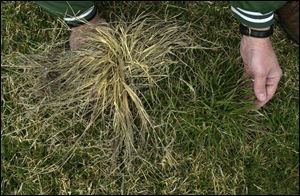
Keep crabgrass at bay with preventive steps
3/19/2003Left unchecked, crabgrass will strike in the next few weeks, so it's important to get a jump on the pesky weed.
Two types of crabgrass can raise havoc in yards. Large crabgrass (Digitaria sanguinalis) has densely hairy leaves and sheaths. Smooth crabgrass (Digitaria ischaemum) does not have hairs on leaves and sheaths, and has a purplish stem.
These fast-spreading annual weeds grow low to the ground with a few upright stems, making them look like a crab.
No matter which variety pops up in your yard, it is a sign that the lawn is under stress. Maybe you have some bald spots from bad drainage, compaction, or even being scalped by a lawn mower. Many weeds are more tolerant of wet and compacted soils than grass cultivars.

Previous season's crabgrass will give way to a new crop.
To prevent crabgrass and other weeds from gaining a foothold, protect your turf by sprinkling it with a pre-emergent herbicide. This type of chemical won't hurt the turf, but it can stop weed seeds before they sprout.
Pre-emergent herbicides are most effective when applied about a week before the crabgrass starts to germinate. In general, weeds start to germinate around the beginning of May, so have your pre-emergent herbicide down in April. If temperatures stay warm, you may even need to apply it by the end of March.
Crabgrass seeds start to germinate when the soil reaches 55 to 60 degrees for seven to 10 days in a row. Many other annual weeds start to germinate when the soil temperatures are above 60 degrees.
Check your soil's temperature with a thermometer. Before it gets that warm, apply this chemical to your lawn and it will stop them from growing.
At the same time, you can give the lawn its first shot of fertilizer for spring. Water the lawn after applying to move the chemical into the soil.
Ohio State University studies show that herbicides containing Pendimethalin, Oxadiazon, DCPA, and Bensulide work the best. They can be used on Kentucky bluegrass, perennial ryegrass, tall fescue, and most fine fescue grasses without hurting turf. Siduron is the only herbicide that will provide control of the annual grass weeds but not hurt the grass you want to keep. Usually it is applied when the lawn is seeded.
Don't apply a pre-emergent herbicide if you expect other seeds or sod to grow. It will kill them off as well. If you plan to plant a spring lawn, find a pre-emergent herbicide especially formulated for spring seeding.
If you lose the early battle with crabgrass and you notice a few patches in the yard, you can try a couple of applications of a post-emergent herbicide such as methanearsonate one to two weeks apart in mid-June.
If you don't want to use chemicals on the lawn, use your hands or hoe to pull the crabgrass out of the ground, trying to grab as much of the root system as possible. If the area is too large and getting out of hand, you may need to rip that part of your lawn up and start over.
Remember, a good crop of healthy, tough, vigorous turf will choke out many weed problems.